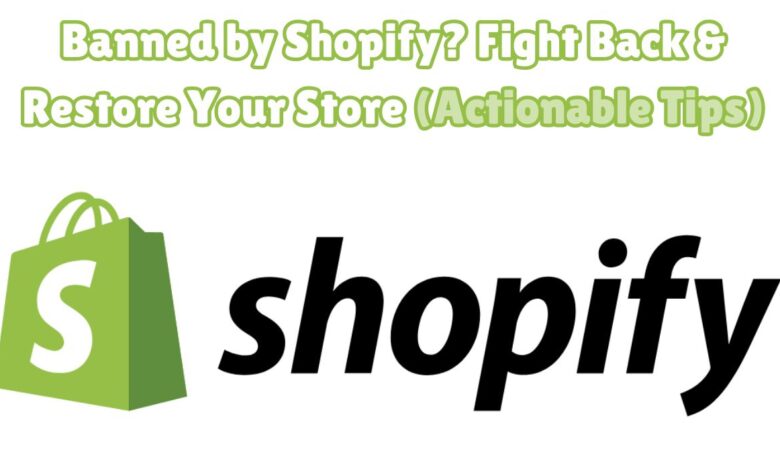Facing a Shopify Ban? Don’t Panic, Here’s How to Get Unbanned!
Learn how to get unbanned from Shopify with our step-by-step guide. Resolve issues and restore your account quickly and effectively.

Running a successful online store on Shopify can be incredibly rewarding. But what happens if you receive a dreaded notification informing you that your account has been banned? Don’t despair! While a Shopify ban can feel like a major setback, there are steps you can take to get your account reinstated and get back to selling.
This comprehensive guide will walk you through the entire process, from understanding the reasons behind your ban to crafting a compelling appeal that increases your chances of success. We’ll cover everything you need to know about getting unbanned from Shopify, so you can get back to focusing on what matters most – growing your business.
Understanding Your Shopify Ban
A Shopify ban can feel like a punch in the gut, especially when you’ve invested time and effort into building your online store. But before you jump into appealing the decision, it’s crucial to understand why your account was banned in the first place.
There are several common reasons for Shopify bans, and knowing the specific cause is vital for crafting an effective appeal. Here are some of the most frequent culprits:
- Violation of Shopify’s Acceptable Use Policy (AUP): This policy outlines the types of products and activities prohibited on the platform. Selling illegal goods, infringing on copyrights, or engaging in misleading marketing practices can all trigger a ban.
- High Chargeback Rates or Fraudulent Activity: Shopify takes payment security very seriously. If your store experiences a high number of chargebacks (customers disputing charges) or exhibits signs of fraudulent activity, your account could be banned.
- Suspicious Payment Gateway Activity: Using unreliable or suspicious payment gateways can raise red flags for Shopify. Sticking to reputable and secure payment processors helps minimize the risk of a ban.
- Failure to Comply with KYC (Know Your Customer) Requirements: Shopify requires businesses to provide accurate and up-to-date customer and business information. Failure to do so can result in account suspension or termination.
Actionable Tip: To determine the exact reason for your ban, carefully analyze any notification emails you received from Shopify. These emails often detail the specific policy violation that triggered the ban.
If the notification is unclear, reaching out to Shopify support can provide further clarification. However, be aware that wait times for support can vary, so patience is key.
Can You Get Unbanned from Shopify?
The possibility of getting unbanned from Shopify depends on the severity of the violation that led to your ban. For minor offenses like a single policy violation that you’ve already addressed, the chances of a successful appeal are much higher.
However, for more serious offenses like repeated policy violations, fraudulent activity, or selling illegal goods, the chances of getting unbanned decrease significantly.
The key takeaway is that proactive action is crucial. By promptly addressing the issue that caused the ban and demonstrating a commitment to future compliance, you increase your chances of regaining access to your Shopify account.
If your appeal is ultimately denied, it’s important to consider your options. This may involve reassessing your business model to ensure it aligns with Shopify’s policies, or exploring alternative e-commerce platforms that better suit your needs.
Steps to Take Before Appealing Your Ban
Before diving headfirst into crafting your appeal, taking some crucial preliminary steps can significantly improve your chances of success. Here’s a breakdown of what you should do:
1. Assess the Damage:
Take a deep breath and analyze the reason for your ban. This involves understanding the specific policy violation and its impact on your business practices. Were there any unintentional mistakes or oversights?
2. Fix the Underlying Issue:
Proactive problem-solving is key. Address the violation head-on. For example, if the ban stemmed from selling prohibited products, remove them from your store immediately. If it was due to high chargebacks, implement stricter customer verification procedures or improve product quality to minimize disputes.
3. Gather Evidence of Correction:
Documenting your efforts to fix the issue strengthens your appeal. This could include screenshots of product removals from your store, invoices for implementing secure payment gateways, or updated customer verification policies.
Pro Tip: Clarity and conciseness are crucial when gathering evidence. Organize your documentation neatly and ensure it directly addresses the violation that led to the ban.
4. Prepare a Compelling Narrative:
Crafting a clear and concise explanation of the situation and your corrective actions is essential. This narrative will form the backbone of your appeal. Here’s a basic outline to get you started:
- Acknowledge the violation: Start by acknowledging the reason for the ban without admitting guilt.
- Explain the corrective actions: Detail the specific steps you’ve taken to address the issue, referencing any supporting evidence you’ve gathered.
- Preventative measures: Outline how you’ll ensure future compliance with Shopify’s policies. This demonstrates your commitment to following the rules.
- Express regret and commitment: Express sincere regret for the inconvenience caused and reiterate your dedication to the Shopify platform.
Appealing Your Shopify Ban: A Step-by-Step Guide
Now that you’ve addressed the root cause of your ban and prepared a compelling narrative, it’s time to craft your appeal. Here’s a step-by-step guide to help you navigate the process:
1. Identifying the Right Contact Method:
While contact methods can occasionally change, Shopify typically handles appeal submissions through their support channels. Head to the Shopify Help Center (https://help.shopify.com/) and search for “appeal account ban.” You should find instructions on how to submit your appeal electronically.
2. Crafting a Strong Appeal:
First impressions matter, so ensure your appeal is professional and well-written. Here’s a breakdown of the key components:
- Subject Line: Craft a clear and concise subject line that grabs Shopify’s attention. Something like “Appeal for Reinstated Shopify Account – [Your Store Name]” works well.
- Introduction: Briefly introduce yourself and your business.
- Reason for Ban: Acknowledge the reason for the ban without admitting fault. Focus on the corrective actions you’ve taken.
- Corrective Actions Taken: Detail the specific steps you’ve taken to address the violation. Include clear and concise references to any supporting evidence you’ve gathered (screenshots, invoices).
- Preventative Measures: Explain how you’ll ensure future compliance with Shopify’s policies. This demonstrates a proactive approach and commitment to the platform.
- Conclusion: Express sincere regret for the inconvenience caused and reiterate your dedication to Shopify.
- Call to Action: Politely request a review of your appeal and a swift response.
Additional Tips:
- Maintain a professional tone throughout the appeal.
- Proofread your appeal carefully before submission. Even minor typos can create a negative impression.
- Be patient. Shopify receives a high volume of inquiries, so a response might take some time.
Timeline for Response:
Unfortunately, there’s no guaranteed timeframe for Shopify’s response to appeals. The processing time can vary depending on the workload and the complexity of your case. However, aiming for a response within a few business days is a reasonable expectation.
Alternative Options if Your Appeal is Denied
While a successful appeal is certainly the desired outcome, there’s always the possibility that Shopify might deny your request. This can be frustrating, but it doesn’t necessarily mean the end of your online business journey. Here are some alternative options to consider:
- Reassess Your Business Model: Take a step back and evaluate your business model. Does it align with Shopify’s Acceptable Use Policy (AUP)? If not, significant changes might be necessary to continue using the platform.
- Migrate to Another Platform: There are several alternative e-commerce platforms available, each with its own set of features and restrictions. Researching platforms that better suit your business needs might be the best course of action.
Remember, a denied appeal doesn’t have to be a complete defeat. By adapting your approach or exploring alternative platforms, you can still find success in the ever-evolving world of online commerce.
Preventing Future Shopify Bans
Getting banned from Shopify can be a costly and time-consuming ordeal. Thankfully, there are several proactive steps you can take to minimize the risk of encountering this issue in the future:
- Stay Informed: Shopify’s Acceptable Use Policy (AUP) is a living document that can be updated periodically. Regularly reviewing the AUP ensures you’re aware of any changes that might impact your business practices.
- Maintain Secure Payment Gateways: Partnering with reputable and secure payment processors like Stripe or PayPal helps prevent suspicious activity flags that can trigger bans.
- Monitor Chargeback Rates: Keeping an eye on your chargeback rate is crucial. Implement customer satisfaction surveys or improve product quality to minimize disputes that could lead to chargebacks.
- Comply with KYC Requirements: Always ensure your customer and business information, including contact details and legal registrations, are accurate and up-to-date within Shopify.
- Build a Positive Reputation: Excellent customer service, high-quality products, and transparent communication go a long way in building trust with your customers and minimizing the risk of disputes that could lead to bans.
By following these preventative measures and demonstrating a commitment to responsible business practices, you can significantly reduce the chances of facing a Shopify ban in the future.
Conclusion
Regaining access to your Shopify account after a ban can feel like a victory. This guide has equipped you with the knowledge and steps necessary to navigate the appeal process and hopefully get back to running your online business. Remember, staying informed, proactive, and compliant with Shopify’s policies are key to long-term success on the platform.
FAQ on Getting Unbanned from Shopify
1. What are some common reasons for Shopify bans?
- Violating Shopify’s Acceptable Use Policy (AUP): This includes selling illegal goods, copyright infringement, or misleading marketing.
- High chargeback rates or fraudulent activity.
- Suspicious payment gateway activity.
- Failure to comply with KYC (Know Your Customer) requirements.
2. Can I get unbanned from Shopify?
The possibility depends on the severity of the violation. Minor offenses with clear corrective actions have a higher chance of successful appeal. However, for serious issues, the chances decrease.
3. What should I do before appealing a Shopify ban?
- Identify the reason: Analyze notifications or contact Shopify support for clarification.
- Fix the underlying issue: Address the violation (e.g., remove prohibited products).
- Gather evidence: Document your corrective actions (screenshots, invoices).
- Craft a compelling narrative: Explain the situation, your actions, and future plans for compliance.
4. How do I appeal a Shopify ban?
- Submit your appeal electronically through Shopify’s support channels (likely the Help Center).
- Structure your appeal with a clear subject line, introduction, explanation, evidence, preventative measures, conclusion, and call to action.
- Maintain a professional tone and proofread carefully.
5. What if my appeal is denied?
- Reassess your business model for alignment with Shopify’s AUP.
- Research alternative e-commerce platforms that better suit your needs.
6. How can I prevent future Shopify bans?
- Regularly review Shopify’s AUP for updates.
- Maintain secure payment gateways (e.g., Stripe, PayPal).
- Monitor and minimize chargeback rates.
- Comply with KYC requirements (accurate customer and business information).
- Build a positive reputation with excellent customer service and high-quality products.

